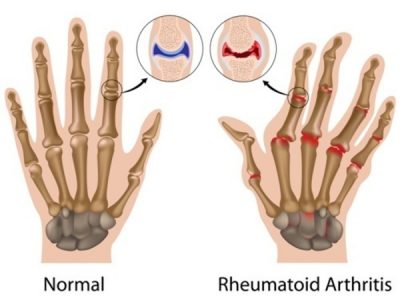
Rheumatoid Arthritis: Here’s How Can You Deal with It

Rheumatoid Arthritis has been classified as an autoimmune disease because it attacks the tissues that line the joints, causing chronic inflammation in the region. While the problem affects the joints, it also has the potential to cause inflammation of other organs such as the skin, heart, lungs and the eyes.
People who have rheumatoid arthritis often experience increasing symptoms—flares— that can last for days or even weeks. They also move into remission when they have few or no symptoms. No cure has been found for rheumatoid arthritis. However, there are medications to stop the progression of the condition and provide relief from symptoms.
 Risk Factors for Rheumatoid Arthritis
Risk Factors for Rheumatoid Arthritis
 According to Arthritis Foundation, this condition affects approximately 1.5 million people in the United States. Women are more prone to developing the condition than men and are often affected between the ages of 30 and 60. Men often develop symptoms later in life. Genetic causes have also been attributed to rheumatoid arthritis. Smoking cigarettes and periodontitis are also considered as risk factors.
According to Arthritis Foundation, this condition affects approximately 1.5 million people in the United States. Women are more prone to developing the condition than men and are often affected between the ages of 30 and 60. Men often develop symptoms later in life. Genetic causes have also been attributed to rheumatoid arthritis. Smoking cigarettes and periodontitis are also considered as risk factors.
Juveniles between the ages of one to 16 can also be affected by this condition. They could suffer from painful and swollen joints that are stiff, fever, and rashes. The condition among juveniles is treated with over-the-counter medications and physical therapy. If the treatments provided do not have any effects, additional medications may be used to provide relief.
 What Causes Rheumatoid Arthritis?
What Causes Rheumatoid Arthritis?
The precise reasons for rheumatoid arthritis haven’t been discovered. However, researchers have identified a number of risk factors. As women are often diagnosed with this condition, it is assumed that estrogen could be playing a role.
Studies have also provided evidence that there is a genetic component to developing this condition. People who smoke are at a higher risk of developing rheumatoid arthritis. Also, occupational exposure to certain types of dust can lead to an increased risk of developing the illness. Bacterial and viral infections are also thought to be a cause for the condition, but studies are still ongoing in this regard.
 What are The Symptoms Of Rheumatoid Arthritis?
What are The Symptoms Of Rheumatoid Arthritis?
Apart from the traditional symptoms of stiff joints and muscles, swelling, and pain, people who have rheumatoid arthritis can also experience other symptoms such as:
- Fatigue.
- Lack of energy.
- Loss of appetite.
- Low-grade fever.
- Bumps under the skin.
- Breathlessness because of inflammation or damages to the lungs.
- Problems with their eyes.
- Hoarseness.
The stiffness of the muscles and joints is at its worst during the mornings and after extended periods of inactivity. Hands are the most affected by rheumatoid arthritis. However, it can also affect the wrists, elbows, knees, feet, hips and even the jaw. Rheumatoid arthritis can be very painful. Chronic inflammation can result in debilitating loss of cartilage, joint deformity and weakness in the bones. It also has the potential to cause problems in other parts of the body including the heart, skin, spleen, and the blood vessels.
 Treatment for Rheumatoid Arthritis
Treatment for Rheumatoid Arthritis
 People seeking treatment for Rheumatoid Arthritis need to approach a rheumatologist or even a pediatrician—a specialist in internal medicine.A person with specialized training can identify and treat over 100 types of arthritis and other autoimmune disorders.
People seeking treatment for Rheumatoid Arthritis need to approach a rheumatologist or even a pediatrician—a specialist in internal medicine.A person with specialized training can identify and treat over 100 types of arthritis and other autoimmune disorders.
Blood tests are usually conducted to diagnose rheumatoid arthritis. The tests look for antibodies and antinuclear bodies which are present in most people that are suffering from this condition. Imaging tests may also be used when conducting the diagnosis.
Presently there is no cure for rheumatoid arthritis. Nonetheless, medications are definitely available to ease the symptoms. The treatments provided mostly aim to cause a mission because the patient feels few or limited symptoms of the condition. Early diagnosis and treatment can minimize or slow down the damage to the joints and the quality of life of the patients.
More in Fitness
-
`
Hair & Makeup Designer Sarah Rubano Talks Turning Mia Goth Into Pearl
Transforming an actor into an unrecognizable character is no small feat, and Mia Goth’s Pearl makeup in the hit movie “Pearl”...
December 17, 2024 -
`
The Physical Signs of Hunger and How Mindful Eating Makes a Difference
Hunger is one of the most basic yet essential signals our body uses to communicate its need for energy. However, many...
December 15, 2024 -
`
Why Did Chris Pratt Call Anna Faris Before Proposing to Katherine?
Chris Pratt, the beloved star of “Guardians of the Galaxy,” made headlines when he revealed that he called his ex-wife, Anna...
December 3, 2024 -
`
6 Proven Tips to Tackle Insurance Claim Denials Successfully
Claim denials are a common hurdle for healthcare providers and professionals, even for those who follow the necessary procedures to avoid...
December 1, 2024 -
`
5 ‘Bad’ Fitness TikTok Trends You Shouldn’t Follow
TikTok has become a haven for creative fitness advice. But not all trends are worth your time or your health. From...
November 23, 2024 -
`
Does Drinking Water Affect Adrenal Hormones?
Drinking water is often seen as a simple way to stay hydrated, but it has deeper effects on our body than...
November 14, 2024 -
`
Why We Feel the Loss of Celebrities So Deeply?
Celebrity grief might sound strange at first. After all, most of us have never met these famous figures in person, yet...
November 5, 2024 -
`
Are High Deductible Insurance Plans as Ideal as They Appear to Be?
High deductible insurance plans have been a hot topic for years, especially as healthcare costs continue to rise. For many Americans,...
October 31, 2024 -
`
How Training Load Data Can Transform Your Exercise Routine
Tracking progress during workouts is challenging. Simple metrics like mileage or time don’t show the whole picture. Understanding the overall effort...
October 26, 2024















You must be logged in to post a comment Login